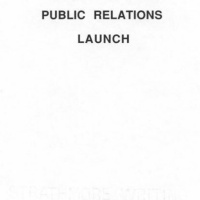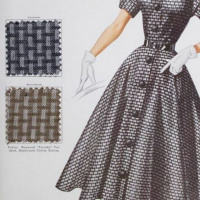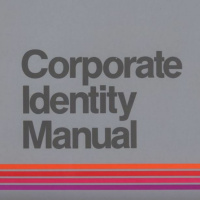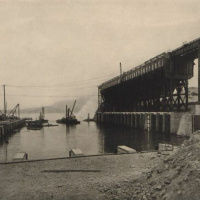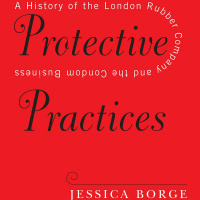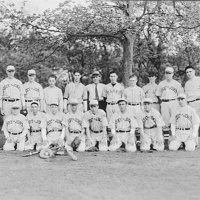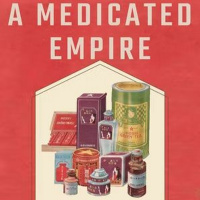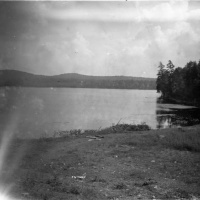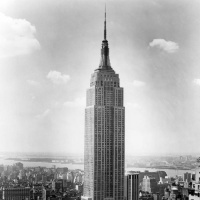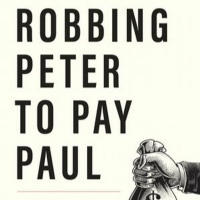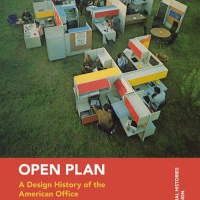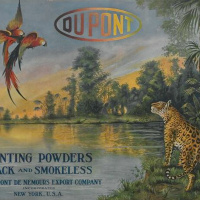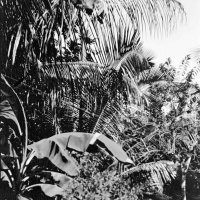Stories From The Stacks
- Author: Vários
- Narrator: Vários
- Publisher: Podcast
- Duration: 78:52:21
- More information
Informações:
Synopsis
Podcast by Hagley Museum and Library
Episodes
-
Working Relationships: A Labor-Centric History of U.S. Public Relations with Patricia Curtin
28/10/2022 Duration: 27minScholars have written histories of public relations. Scholars have written histories of labor. Scholars had yet to bring the two histories into conversation with one another, that is until Patricia Curtin, professor at the University of Oregon, started her latest book project. Dr. Curtin’s research illustrates the many connections between public relations and American labor in the early twentieth century. Whereas capital had its public relations gurus, such as Ivy Lee, so too did the labor movement, with Mother Jones and the IWW leading the way. The struggle for control over firms, economic resources, and business management pivoted, at least in part, on public opinion. Neither capital nor labor could afford to lose the opportunity to cultivate public support, and both sides went at it with gusto. Over the long term, capital had the upper hand. But successful and popular unionization efforts in the twenty-first century, such as that organized by Starbucks workers, may indicate a turning tide in the story. I
-
Synthetic Fashion & the Mad Russian with Regina Blaszczyk
17/10/2022 Duration: 52minDuPont was in the fashion business. The industrial giant cultivated markets for its novel synthetic textiles, such as Rayon, by interfacing with the wider world of fashion. This process brought one Alexis Ureyvitch Sommaripa, later known as “The Mad Russian,” to prominence. This elegant, cultured man was born in the Russian Empire in Odessa, Ukraine, fled the revolution as a teenager, and migrated to the United States with the goal to become “a rich American.” From there, his path led him through Harvard, Alabama, Lowell, Buffalo, to New York City. Along the way, he shaped the ways in which DuPont did business, and how American women preferred to dress. Professor Regina Blaszczyk, business historian at the University of Leeds, tells the story of Sommaripa as part of her book project, The Synthetics Revolution. Sommaripa developed statistical methods to describe the textile and fashion markets, used this information to influence production techniques, and eventually headed the DuPont Fabric Development Servic
-
Imagining the Future of Business, 1961-1996 with Gavin Benke
03/10/2022 Duration: 28minCorporate futurists made a living with their imaginations. These professional prognosticators spent their time looking at the world around them, observing its apparent changes and trends, and reporting to business and political leaders proscribed methods for interpreting and preparing for the future. Dr. Gavin Benke, senior lecturer at Boston University, dug into multiple Hagley Library collections, including those of the Chamber of Commerce, National Association of Manufacturers, and Conference Board, to explore the careers and influence of twentieth-century corporate futurists. Beginning in the 1960s, corporate futurists extrapolated from social trends to predict a future business environment where people would demand a higher level of service from corporations, and turn to corporations for leadership, structure, and meaning in the post-national world economy then developing. Whereas during the 1970s this vision found eager listeners in major American corporations, trade associations, and perhaps especial
-
Empire of Steel: Bethlehem in Latin America with Cory Fischer Hoffman
19/09/2022 Duration: 33minThe Empire of Bethlehem Steel stretched from a small eastern-Pennsylvania city across the United States and down to Cuba, Mexico, Venezuela, Chile, and Brazil. It encompassed dozens of plants, concerns, and subsidiary firms, and touched the lives of millions of people across multiple continents. During a century (1880s-1980s) of involvement in Latin America, Bethlehem Steel Company imported cheap materials (iron, manganese) while exporting technical, corporate, and social practices developed in the United States. Telling this story is Dr. Cory Fischer Hoffman, visiting assistant professor at Lafayette College, whose research into the Bethlehem Steel Company uncovers the global connections that underpinned company success over the twentieth century. Company interests in the mineral economy of Latin America persisted from wholly-owned iron mines in Cuba Chile, through their loss during the period of “resource nationalism” in the region, to minority-stake ownership of manganese mines in Mexico and Brazil. Usin
-
Protective Practices: A History of the Condom Business with Jessica Borge
06/09/2022 Duration: 59minFrom humble beginnings wholesaling at a small tobacconist-hairdresser shop in 1915, the London Rubber Company rapidly became the UK's biggest postwar producer and exporter of disposable rubber condoms. A first-mover and innovator, the company's continuous product development and strong brands (including Durex) allowed it to dominate supply to the retail trade and family planning clinics, leading it to intercede in the burgeoning women's market. When oral contraceptives came along, however, the company was caught in a bind between defending condoms against the pill and claiming a segment of the new birth control market for itself. In this first major study on the company, Jessica Borge shows how, despite the "unmentionable" status of condoms that inhibited advertising in the early twentieth century, aggressive business practices were successfully deployed to protect the monopoly and squash competition. Through close, evidence-based examination of LRC's first fifty years, encompassing its most challenging dec
-
Company Unions & Worker Identity with Alex Fleet
22/08/2022 Duration: 29minDuring the 1920s, major American corporations established in-house labor unions to address worker agitation. Labor historian Alex John Fleet, PhD candidate at Wayne State University, explores the phenomenon in his dissertation research. Seeking to uncover how company unions intersected with changing labor-management relations, and broader changes in the workplace social environment, Fleet explored the archives of several large firms of the era, notably Goodyear rubber held in Ohio, and Bethlehem Steel held at the Hagley Library. Both companies established in-house labor unions, and organized means for worker representatives to air and possibly seek redress of grievances. Company unions were not all made the same. Goodyear based its “industrial assembly” on the United States Congress, and endowed it with the capacity to discuss wages and other matters critical to worker satisfaction. Nevertheless, assembly representatives received additional pay from the company, locking them into a conflict of interests bet
-
Your Friend the Boss: Corporate Social Responsibility at DuPont, 1900-1940 with Jeffrey Muldoon
08/08/2022 Duration: 28minWhich is better for business, keeping workers happy, or keeping workers in line? The movement for corporate social responsibility (CSR) argued that management and workers shared a partnership that could multiply productivity and profits if properly nurtured. While labor unrest had roiled the business world for a generation, many leading American firms reacted by maintaining paramilitary private police forces. Not only was this expensive, but it was also ineffective and often counterproductive to managerial goals. During the early twentieth century a new set of ideas about how to manage workers for company benefit emerged with an opposite set of techniques. Dr. Jeffrey Muldoon examines this turn toward CSR, or “welfare capitalism,” as enacted by the E.I. du Pont de Nemours & Company firm, among the leading lights of the movement in the United States. By diving especially into the John J. Raskob papers, Muldoon uncovered the many social and financial methods deployed by DuPont management to create a more sati
-
A Medicated Empire: The Pharmaceutical Industry & Modern Japan with Timothy Yang
25/07/2022 Duration: 31minIn "A Medicated Empire," Dr. Timothy Yang, associate professor at the University of Georgia, explores the history of Japan's pharmaceutical industry in the early twentieth century through a close account of Hoshi Pharmaceuticals, one of East Asia's most influential drug companies from the late 1910s through the early 1950s. Focusing on Hoshi's connections to Japan's emerging nation-state and empire, and on the ways in which it embraced an ideology of modern medicine as a humanitarian endeavor for greater social good, Yang shows how the industry promoted a hygienic, middle-class culture that was part of Japan's national development and imperial expansion. Yang makes clear that the company's fortunes had less to do with scientific breakthroughs and medical innovations than with Japan's web of social, political, and economic relations. He lays bare Hoshi's business strategies and its connections with politicians and bureaucrats, and he describes how public health authorities dismissed many of its products as pl
-
Technological Change & Work with Ben Schneider
11/07/2022 Duration: 32minWhat happens to jobs when technology changes? How do new technologies change the ways people experience and think about work? Economic historian Ben Schneider, Postdoctoral Fellow at the Work Research Institute at Oslo Metropolitan University, explores these questions and more in his research on technology and work. Taking textile manufacturing and transportation as his case studies, Dr. Schneider developed a novel matrix for analyzing changes in work over time as measured not only quantitatively by wages and hours, but also qualitatively by security, satisfaction, safety, and similar social metrics. This framework allows him to recover and analyze changes in work regimes brought about or otherwise influenced by changes in technology. Dr. Schneider used multiple Hagley Library collections to uncover his story, including materials from our world-class archive of United States railroad companies, like the Pennsylvania Rail Road, the Reading Rail Road, and others. Reading this archive through his framework, Sch
-
The Literary & Ecological History of Lake Hopatcong with Peter Astras
27/06/2022 Duration: 34minHudson Maxim wanted his lake, and he didn’t mind twisting some arms to get it. The early-twentieth-century investor in Lake Hopatcong property wished to make it a destination for well-heeled travelers and pleasure seekers. Making his plans difficult were a cadre of challenges from intransigent executives, to the Morris Canal, to the hydrography of the lake itself. Environmental scholar Peter Astras, PhD candidate at St. Johns University, tells the tale of Lake Hopatcong as an object of desire, development, and indeterminate outcomes. Astras came to the Hagley Library to explore the Hudson Maxim papers, a collection that ranges across the wide array of the man’s business and personal interests. Through careful reading of the archive, he was able to piece together a story that situates the lake in broader context of economic and environmental change. For more Hagley History Hangouts, and more information on the Center for the History of Business, Technology, & Society, visit us on line at www.hagley.org.
-
Born in the USA/Made in the GDR: Western Popular Music & a Communist Record Market with Sven Kube
13/06/2022 Duration: 31minWhat did the Cold War sound like? How did political ideologies shape the differing experiences of musicians and consumers in the capitalist versus the communist world? Did the Iron Curtain muffle the raucous sounds of western popular music? Or were consumers in communist countries able to access capitalist pop? All these questions and more find answers in the work of cultural historian, and 2022 Hagley-NEH Postdoctoral Fellow, Dr. Sven Kube. Blending archival research with oral history and personal experiences, Kube uncovers the fascinating story of a worldwide youth culture of popular music bisected by the geopolitical divisions of the Cold War period. From the 1960s to the 1980s, the grassroots innovation taking place in western popular music could not be replicated in the centrally-planned economies of the east. Nevertheless, eastern consumers, especially in the German Democratic Republic, got their hands (and ears) on novel music and sonic forms emanating from the west. Kube traces these connection throu
-
The Economics of the Empire State Building with Jason Barr
30/05/2022 Duration: 29minThe tallest building of its day opened as the Great Depression really began to squeeze the American economy. Was the Empire State Building a gigantic folly perpetrated by men with sky-scraping egos? Folks in the 1930s thought so, calling the monument the “Empty State Building,” because so little of its space had been rented. Yet, when viewed from the vantage of the twenty-first century through the lens of archival documents, the Empire State Building resolves into an economically and culturally successful investment made by people with enormous fortunes motivated both by egotism and broad vision. Economist Jason Barr, professor at Rutgers University - Newark, dug into the records of John J. Raskob and Pierre Samuel du Pont records held by the Hagley Library to uncover an insider’s story of the Empire State Building. Conceived by Raskob, and backed by du Pont, the project launched in 1929, weeks before the stock market crash, and opened for business in 1931, after a record-setting rapid construction. While th
-
Nature’s Brew: An Environmental History of American Brewing with Cody Patton
16/05/2022 Duration: 30minHow many species had a hand in making that glass of beer? From the perspective of environmental history, human artefacts like beer result from more-than-human collaboration across time. Barley plants, hop vines, single-cell organisms, and a multiplicity of humans work together to bring beer into existence, and react to changes in the meteorological and economic climates. Taking these interactions seriously allows us to better understand the history of American brewing, and its implications for the future of business in an era of climate change. Environmental historian Cody Patton, PhD candidate at Ohio State University, is uncovering this history in his dissertation project. Using multiple Hagley Library collections, including our unrivaled collection of trade journals and an oral history of craft brewing, Patton traces the many connections between environmental and economic factors in American history, as mediated by the brewing and consumption of beer. Scientific knowledge, industrial practice, professiona
-
Robbing Peter to Pay Paul with Samuel Milner
02/05/2022 Duration: 43minConcentrated market power and the weakened sway of corporate stakeholders over management have emerged as leading concerns of American political economy. In his book, Robbing Peter to Pay Paul: Power, Profits, and Productivity in Modern America, Samuel Milner provides a historical context for contemporary efforts to resolve these anxieties by examining the contest to control the distribution of corporate income during the mid‑twentieth century. During this “Golden Age of American Capitalism,” apprehension about the debilitating consequences of industrial concentration fueled efforts to ensure that management would share the fruits of progress with workers, consumers, and society as a whole. Focusing on wage and price determination in steel, automobiles, and electrical equipment, Milner reveals how the management of concentrated industries understood its ability to distribute income to its stakeholders as well as why economists, courts, and public policymakers struggled to curtail the exercise of that market p
-
Tax the Rich: Teachers’ Fight to Fund Public Schools with Kelly Goodman
18/04/2022 Duration: 19minTax the Rich: Teachers’ Fight to Fund Public Schools with Kelly Goodman Education is among the largest public expenditures in the United States. How is school funding determined, and by whom? Between 1930 and 1980, teachers organized with allies to create new streams of funding to support public education, while their opponents counter-organized to reduce the ability of state governments to collect taxes and fund public services. By the end of the era, anti-tax interests have gained the ascendant, divided the pro-tax coalition, and put teachers on their back heel. Kelly Goodman, adjunct professor at West Chester University, uncovers this tale as it unfolded in California and Michigan with innovative archival research and original analysis. Using the National Association of Manufacturers and the United States Chamber of Commerce collections held at the Hagley Library, Dr. Goodman did real detective work to piece together the reaction against progressive taxation organized by business interests. The pro-busi
-
“People of Some Talent & So Much Virtue”: Forgotten Lives of du Pont Women with Kelsey McNiff
04/04/2022 Duration: 29minSilence speaks volumes. Especially silences in historical memory, which reflect the values of a society as it chooses what and whom to remember. The du Pont family’s arrival in the United States is a well-worn tale of visionary men; what about the women of the family, their lives, perspectives, and contributions? The low profile of du Pont women in historical memory compared to that of their male counterparts reflects not a lack of sources or evidence (there is plenty of both), but a choice by researchers, writers, and historians to emphasize certain aspects of the story, and to forget other parts deemed less significant. Kelsey McNiff, associate professor of English at Endicott College, addresses this discrepancy in her original research on the lives of du Pont family women. Supported by an exploratory grant from the Center for the History of Business, Technology, & Society, Dr. McNiff dug into the rich collections of du Pont family archives held by the Hagley Library. These sources added a wealth of eviden
-
Open Plan: A Design History of the American Office with Jennifer Kaufmann-Buhler
21/03/2022 Duration: 49minImagine an office without walls or hierarchies, a space that allows for the free and open exchange of ideas and a way to work… better. How would one implement this? More importantly, what happens when design ideals collide with workplace reality? Jennifer Kaufmann-Buhler’s new book, Open Plan: A Design History of the American Office answers these questions. Kauffman-Buhler traces the evolution of the brightly colored officescapes of the 1960s and 1970s to the cubicles of the 1980s and 1990s and analyzes these changing office spaces as design concepts promoted by architects, designers, and furniture makers, and as work space used by organizations and their employees. Jennifer Kaufmann-Buhler is an Assistant Professor at the Rueff School of Design, Art, and Performance at Purdue University in West Lafayette, Indiana. Her research focuses on the interactions and intersections of people, space, and things in everyday life. To support her work, Dr. Kaufmann-Buhler received research funding from the Center for t
-
Industrial Semiotics: United States Visual Culture, 1880s to the 1950s with Derek Vouri-Richard
07/03/2022 Duration: 30minTwenty-first-century Americans are saturated with visual imagery and punchy messages authored by large organizations. This was not always so. Techniques for standardized mass communication developed in the late nineteenth century, such as photography, inexpensive printing, “magic lanterns,” and motion pictures, offered organization leaders unprecedented means to create shared understandings of facts and symbols across large groups of people. The study of the process by which symbolic meanings are promulgated through social groups is called semiotics, and the period between the 1880s and the 1950s offers the semiotician a rich study of dramatic change. Derek Vouri-Richard, a PhD candidate in American Studies at the College of William & Mary, came to the Hagley Library to research the semiotics of corporate communications. He dug into multiple collections and discovered the development of a distinctive vocabulary of visual images paired with clear and concise text that characterized the corporate semiotics of
-
The Not So Inexhaustible Sea: Fisheries Science & Management with Aaron Van Neste
21/02/2022 Duration: 28minHow many fish can people catch before we exhaust the supply? Fisheries managers have deployed the language and techniques of science since the mid-nineteenth century in an intergenerational attempt to find out. Their efforts were part of a longer debate over whether the seas are an inexhaustible resource for human exploitation, or whether there are practical limits to the sustainability of marine resource extraction. Scientists developed models of fish reproduction, and theories of ecological stability, that inform the approach taken by regulators toward fishery management. Yet, as scientific understanding has evolved over two centuries, public regulation and popular understanding of fishing industries has lagged behind. Historian of science Aaron Van Neste suggests that the application of scientific understandings to fisheries management has had unintended consequences for marine ecology, and for the economic sustainability of the industry. The scientific perspective on fisheries has changed from a beginnin
-
Oil Palm: A Global History with Jonathan Robins
07/02/2022 Duration: 39minOil palms are ubiquitous - grown in nearly every tropical country, they supply the world with more edible fat than any other plant and play a role in scores of packaged products, from lipstick and soap to margarine and cookies. And as Jonathan E. Robins shows, sweeping social transformations carried the plant around the planet. First brought to the global stage in the holds of slave ships, palm oil became a quintessential commodity in the Industrial Revolution. Imperialists hungry for cheap fat subjugated Africa’s oil palm landscapes and the people who worked them. In the twentieth century, the World Bank promulgated oil palm agriculture as a panacea to rural development in Southeast Asia and across the tropics. As plantation companies tore into rainforests, evicting farmers in the name of progress, the oil palm continued its rise to dominance, sparking new controversies over trade, land and labor rights, human health, and the environment. By telling the story of the oil palm across multiple centuries and co

